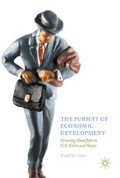Abstract
This chapter explores the economic development impacts of human capital, defined as the education and skills that workers use in their jobs. Examining the impacts of multiple indicators of human capital, Gabe shows that educational attainment, the percentage of a region’s workforce in creative occupations, and several types of job-related skills (e.g., critical thinking, management, technology, idea generation) help the growth of good jobs. Several of the human capital indicators positively impact the growth and productivity of metropolitan areas, suggesting that these characteristics are contributing to a divergence of the economic fortunes of US regions. The impacts of educational attainment and creative economy employment are considerably stronger in metropolitan areas, especially very large regions, as compared to states.
Access this chapter
Tax calculation will be finalised at checkout
Purchases are for personal use only
Notes
- 1.
This figure was calculated using data from the U.S. Bureau of Labor Statistics.
- 2.
These statistics were calculated using data from County Business Patterns of the U.S. Census Bureau.
- 3.
These figures are from the U.S. Bureau of Labor Statistics.
- 4.
Vijay Mathur (1999) also argues that human capital helps regions “directly” through the high productivity of educated and skilled workers and “indirectly” through “spillover effects.”
- 5.
For more information about O*NET, see the article by Norman Peterson and (numerous) colleagues (2001).
- 6.
Educational attainment figures are from the U.S. Census Bureau.
- 7.
These nine states are Colorado, Connecticut, Maryland, Massachusetts, New Hampshire, New Jersey, New York, Vermont, and Virginia.
- 8.
These metros are Ames (Iowa), Ann Arbor (Michigan), Boston, Boulder (Colorado), Bridgeport (Connecticut), Columbia (Missouri), Corvallis (Oregon), Durham-Chapel Hill (North Carolina), Gainesville (Florida), Iowa City (Iowa), Ithaca (New York), San Francisco, San Jose, Santa Fe (New Mexico), Trenton (New Jersey), and Washington D.C.
- 9.
A study by Brian Knudsen et al. (2008) also found a positive interaction between the effects of big cities (i.e., population density) and creativity.
- 10.
References
Abel J, Gabe T (2011) Human capital and economic activity in urban America. Regional Studies 45: 1079–1090.
Abel J, Dey I, Gabe T (2012) Productivity and the density of human capital. Journal of Regional Science 52: 562–586.
Abel J, Gabe T, Stolarick K (2014) Skills across the urban-rural hierarchy. Growth and Change 45: 499–517.
Autor D, Levy F, Murnane R (2003) The skill content of recent technological change: An empirical investigation. Quarterly Journal of Economics 118: 1279–1333.
Bacolod M, Blum B, Strange W (2009) Skills in the city. Journal of Urban Economics 65: 136–153.
Card D (1999) The causal effect of education on earnings. In: Ashenfelter O, Card D (eds) Handbook of Labor Economics, Vol 3, Elsevier, Amsterdam, p 1801–1863.
Ciccone A, Hall R (1996) Productivity and the density of economic activity. American Economic Review 86: 54–70.
Feser E (2003) What regions do rather than make: A proposed set of knowledge-based occupation clusters. Urban Studies 40: 1937–1958.
Florida R (2002) The Rise of the Creative Class, Basic Books, New York.
Florida R (2012) The Rise of the Creative Class, Revisited, Basic Books, New York.
Florida R, Mellander C, Stolarick K (2008) Inside the black box of regional development—Human capital, the creative class and tolerance. Journal of Economic Geography 8: 615–649.
Gabe T (2009) Knowledge and earnings. Journal of Regional Science 49: 439–457.
Gabe T (2011) The value of creativity. In: Andersson D, Andersson A, Mellander C (eds) Handbook of Creative Cities, Edward Elgar, Cheltenham, United Kingdom, p 128–145.
Gabe T, Florida R, Mellander C (2013) The creative class and the crisis. Cambridge Journal of Regions, Economy and Society 6: 37–53.
Glaeser E (2011) Triumph of the City, The Penguin Press, New York.
Glaeser E, Resseger M (2010) The complementarity between cities and skills. Journal of Regional Science 50: 221–244.
Glaeser E, Saiz A (2003) The rise of the skilled city. Harvard Institute of Economic Research, Discussion Paper No 2025, December.
Knudsen B, Florida R, Stolarick K, Gates G (2008) Density and creativity in US regions. Annals of the Association of American Geographers 98: 461–478.
Krugman P (1997) The Age of Diminished Expectations, The MIT Press, Cambridge, MA.
Levy F, Murnane R (2004) The New Division of Labor, Princeton University Press, Princeton, NJ.
Markusen A (2004) Targeting occupations in regional and community economic development. Journal of the American Planning Association 70: 253–268.
Mathur V (1999) Human capital-based strategy for regional economic development. Economic Development Quarterly 13: 203–216.
Moretti E (2004a) Workers’ education, spillovers, and productivity: Evidence from plant-level production functions. American Economic Review 94: 656–690.
Moretti E (2004b) Estimating the social return to higher education: Evidence from longitudinal and repeated cross-sectional data. Journal of Econometrics 121: 175–212.
Peterson N, Mumford M, Borman W, Jeanneret P, Fleishman E, Levin K, Campion M, Mayfield M, Morgeson F, Pearlman K, Gowing M, Lancaster A, Silver M, Dye D (2001) Understanding work using the Occupational Information Network (O*NET): Implications for practice and research. Personnel Psychology 54: 451–492.
Rauch J (1993) Productivity gains from geographic concentration of human capital: Evidence from the cities. Journal of Urban Economics 34: 380–400.
Sveikauskas L (1975) The productivity of cities. Quarterly Journal of Economics 89: 393–413.
Author information
Authors and Affiliations
Rights and permissions
Copyright information
© 2017 The Author(s)
About this chapter
Cite this chapter
Gabe, T.M. (2017). Human Capital and the Growth of Good US Jobs. In: The Pursuit of Economic Development. Palgrave Macmillan, Cham. https://doi.org/10.1007/978-3-319-52476-4_4
Download citation
DOI: https://doi.org/10.1007/978-3-319-52476-4_4
Published:
Publisher Name: Palgrave Macmillan, Cham
Print ISBN: 978-3-319-52475-7
Online ISBN: 978-3-319-52476-4
eBook Packages: Social SciencesSocial Sciences (R0)

